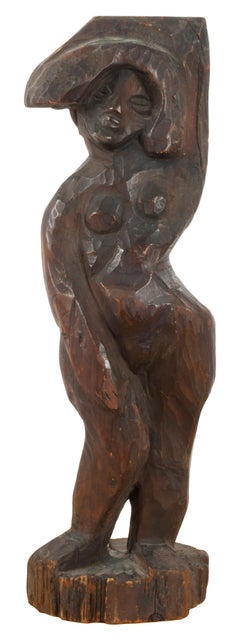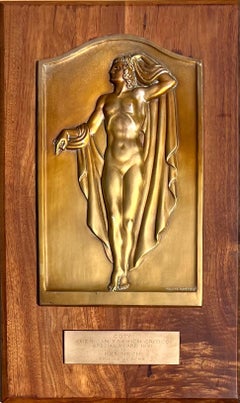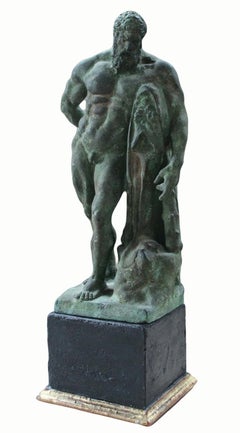Thomas French Fine Art Nude Sculptures
to
1
Overall Width
to
Overall Height
to
1
1
1
1
1
1
1
1
1
1
Standing Female Nude After Alexander Archipenko
By Walt Kuhn
Located in Fairlawn, OH
Illustrated: "Walt Kuhn, Painter, His Life and Work, by Phillip Rhys Adams, page 67, plate 27, Courtesy of Kennedy Galleries-Kuhn Estate (see photo)
Kuhn’s sculptures were collected...
Category
1910s Cubist Figurative Sculptures
Materials
Wood
Related Items
1961 Coty Award Plaque Kenneth Hairdresser Jacqueline Onassis Bronze Fashion
Located in New York, NY
1961 Coty Award Plaque Kenneth Hairdresser Jacqueline Onassis Bronze Fashion
Bronze on wood. The wood plaque measures 12 3/4" by 20 3/4 inches. The bronze plaque itself is 13 3/4 x 8 3/4 inches and the the bronze inscription, which reads "COTY, American Fashion Critics Special Award 1961 to KENNETH of LILY DACHE...
Category
1960s American Modern Figurative Sculptures
Materials
Bronze
Late 18th Century Bronze Sculpture after the Farnese Hercules
Located in Beachwood, OH
Late 18th Century Bronze Sculpture after the Farnese Hercules
Grand Tour bronze with a fine encrusted patination on a later wooden base
16 in. h., overall
12.5 in. h., bronze
3.5 in...
Category
Late 18th Century Figurative Sculptures
Materials
Bronze
Large George Aarons Terracotta Sculpture Relief Art Deco Plaque WPA Artist
By George Aarons
Located in Surfside, FL
Two Figures (Mother and son)
9" x 17" terracotta sculpture, signed lower left mounted to wood panel, 15 1/2" x 23 1/2"
George Aarons (born Gregory Podubisky, in St. Petersburg, Russ...
Category
20th Century Art Deco Figurative Sculptures
Materials
Wood, Terracotta
Sydney Kumalo Bronze Minimalist African Modernist Sculpture Figural Female Nude
Located in Surfside, FL
Sydney Kumalo. Features a bronze stylized female figural form sculpture fixed to a marble plinth and wood base. Bears signature on base. Measures 9 1/2" x 4 1/4". There is no edition number on the piece.
Sydney Kumalo (1935 - 1988) was born in Sophiatown, Johannesburg, on 13 April 1935. His was one of the families who had to move out of the "white" city to the South Western Townships, or Soweto. Raised in Diepkloof and educated at Madibane High School, he took with him from old Sophiatown the curious and diverse heritage of its heyday. Art classes in the Catholic school, "Sof' town" blues and jazz, the vibrant street culture and growing defiance of its population of various races who were gradually forced out into separate race-group areas. So it was that these various aspects of his early life created for Kumalo a cultural mix of a Zulu family related to the traditional royal house; city schooling, nascent township music and lingo; growing urbanised political defiance and the deep-rooted Zulu pride and respect for the legends and ancient stories of a tribal people. This mix of old and new cultures was reinforced when he began his studies at the Polly Street Art Centre in 1953 where he became a member of Cecil Skotnes group of serious artists who were encouraged to acquire professional skills. Skotnes introduced a basic training programme with modelling as a component, which marked the introduction of sculpting (in brick-clay) at Polly Street.
Kumalo was Skotnes’ assistant at Polly Street from 1957 to 1964, and having recognised his great talent as a sculptor, Skotnes encouraged him to become a professional artist.
After Kumalo’s very successful assistance with a commission to decorate the St Peter Claver church at Seeisoville near Kroonstad, with painting designs, sculpture and relief panels in 1957, Skotnes arranged for Kumalo to continue his art training by working in Edoardo Villa ’s studio from 1958 to 1960. Working with Villa, he received professional guidance and began to familiarize himself with the technical aspects of sculpting and bronze casting. In 1960 he became an instructor at the Polly Street Art Centre.
Kumalo started exhibiting his work with some of the leading commercial Johannesburg galleries in 1958, and had his first solo exhibition with the Egon Guenther Gallery in 1962. He was a leader of the generation who managed to leave behind the forms of African curios, reject the European-held paternalism which encouraged notions of "naive" and "tribal" African art, and yet still hold fast to the core of the old legends and spiritual values of his people. He introduced these subjects into his bronze sculptures and pastel drawings, evolving his own expressive, contemporary African "style".
Together with Skotnes, Villa, Cecily Sash and Giuseppe Cattaneo, Kumalo became part of the Amadlozi group in 1963. This was a group of artists promoted by the African art collector and gallery director Egon Guenther, and characterised by their exploration of an African idiom in their art. Elza Miles writes that Cecil Skotnes’ friendship with Egon Guenther had a seminal influence on the aspirant artists of Polly Street: “Guenther broadened their experience by introducing them to German Expressionism as well as the sculptural traditions of West and Central Africa. He familiarised them with the work of Ernst Barlach, Käthe Kollwitz, Gustav Seitz, Willi Baumeister and Rudolf Sharf.” It is therefore not surprising that some of Kumalo’s sculptures show an affinity with Barlach’s powerful expressionist works. Guenther organised for the Amadlozi group to hold exhibitions around Italy, in Rome, Venice, Milan and Florence, in both 1963 and 1964.
Kumalo’s career took off in the mid 1960s, with his regular participation in exhibitions in Johannesburg, London, New York and Europe. He also represented South Africa at the Venice Biennale in 1966, and in 1967 participated in the São Paulo Biennale.
EJ De Jager (1992) describes Kumalo’s sculpture as retaining much of the “canon and formal aesthetic qualities of classical African sculpture. His work contains the same monumentality and simplicity of form.” His main medium for modelling was terra cotta, which was then cast in bronze, always paying careful attention to the finish of both the model as well as the final cast. He began casting the pieces he modelled in clay or plaster into bronze at the Renzo Vignali Artistic Foundry in Pretoria North. He worked throughout his life with its owners, the Gamberini family, and enjoyed learning the technical aspects of the casting process, refining his surfaces according to what he learned would produce the best results in metal. De Jager further writes that Kumalo’s distinctive texturing of the bronze or terra cotta is reminiscent of traditional carving techniques of various African cultures. “In many respects Kumalo thus innovated a genuine contemporary or modern indigenous South African sculpture”. Kumalo came to admire the works of the Cubists, and of British sculptors Henry Moore and Lynn Chadwick. He became noted for adapting shapes from them into his own figures. The success of his use of the then current monumental simplicity and purely aesthetic abstractions of natural forms has been emulated by many South African sculptors since the 1970s.
He was in many ways the doyen of South African Black art. As such he was an important influence especially on younger African sculptors, by whom he is greatly revered. Through his teaching at Polly Street and at the Jubilee Centre, as well as through his personal example of integrity, dedication and ability, he inspired and guided students who in their own right became outstanding artists, for example, Ezrom Legae, Leonard Matsoso and Louis Maqhubela
From 1969 onward, he allied himself with Linda Givon, founder of The Goodman Gallery in Johannesburg, where he exhibited regularly until his death in December 1988. Working with Givon also perpetuated his associations with his many friends of strong principles. Skotnes, Villa, Legae and later such peers from the Polly Street era as Leonard Matsoso, Durant Sihlali and David Koloane have all exhibited at The Goodman Gallery. Kumalo, Legae, and later Fikile (Magadlela) and Dumile (Feni) were among the leading exponents of a new Afrocentric art...
Category
20th Century Modern Figurative Sculptures
Materials
Marble, Bronze
Abstract Modernist Armless Female Nude Torso Bust Bronze Sculpture
Located in Houston, TX
Modernist nude bronze sculpture by Houston, TX artist David Adickes. The sculpture depicts an abstract armless female nude torse that stands on a wooden base. The piece is signed by the artist at the back of the sculpture's left leg.
Artist Biography: Born (1927) and raised in Huntsville, TX, David Adickes is an artist whose art and heart are closely aligned with Paris, France. After studying art at the Atelier F. Leger in the late 40s, Adickes burst onto the art scene in Houston and elsewhere in the early 50s and has been a prominent member of Houston’s art community ever since. While his most visible works are his giant sculptures, from the Virtuoso in downtown Houston...
Category
Early 2000s Modern Nude Sculptures
Materials
Bronze
Four Surrealist Skeletal Figures Unique Painted Mini Folding Screen
Located in Long Island City, NY
A very cool and stylish mini folding screen of carved figures hand painted by an unknown artist. It is likely from around 1970, the figures are a bit surrealist and match in a stiff ...
Category
1970s Surrealist Figurative Sculptures
Materials
Wood, Paint
H 24 in W 30 in D 1 in
Large Mahogany Relief of Prometheus, The Giver of Fire in Style of Peterpaul Ott
Located in Soquel, CA
Large Scale Mahogany Wood Relief Sculpture of Prometheus, The Giver of Fire In the Style of WPA artist Peterpaul Ott
Wonderfully executed wood r...
Category
1950s Abstract Impressionist Figurative Sculptures
Materials
Wood, Mahogany
H 50.5 in W 44 in D 2 in
'Woman Standing', Modernist Sculpture, San Francisco Bay Area, de Young Museum
By Wedo Georgetti
Located in Santa Cruz, CA
Inscribed on base, 'W.G.' for Wedo Georgetti (American, 1911-2005) and created circa 1950. Acquired directly from the artist and accompanied by certificate of authenticity.
Born in Italy, this California Post-Impressionist came to the United States at the age of one. Georgetti first worked as a merchant seaman to support his art studies and traveled all over the world accumulating sketches, many of which he later worked up into paintings. He made frequent visits to France, where he was influenced by the Post-Impressionists and, particularly, by the Nabis. An innovative theorist, Georgetti was the originator of the style known as California Fauvism. He exhibited widely and with success, both at exhibitions and at one-man shows (Oakland Art Gallery, 1942-44; Society of American Graphic Artists, NYC, 1944; Maxwell Galleries, 1940’s; de Young Museum...
Category
1950s Modern Nude Sculptures
Materials
Wood
Places In The Heart, Nut wood sculpture on steel base, female nude, brown
By Troy Williams
Located in Santa Fe, NM
Places In The Heart, Nut wood sculpture on steel base, female nude, brown, Williams
Sculptor Troy Williams unites the timeless and the contemporary in sculptures of rare beauty and meaning Beyond all the narrative potential of the three obvious physical dimensions of Troy Williams’ sculpture, there are many other considerations that contribute greatly to the enjoyment, appreciation, and understanding of his entrancing 360-degree works of figurative art. Among these are the emotional responses and intellectual interpretations that first go into the artist’s creative process and then into every subsequent spectator’s viewings at least somewhat differently each time. Some artists insist on leaving these entirely up to each viewer, but Williams is glad to enrich the experience by inviting the viewer in for a little insight into the artist’s intention. Certain ambiguities and unintended provocations might otherwise arise, as Williams uses original combinations of materials or ideas in highly original ways. Williams specializes in figurative and facial sculptures...
Category
2010s Contemporary Figurative Sculptures
Materials
Steel
H 51.5 in W 10 in D 10 in
Male Classical Torso
By Larry Scaturro
Located in Brooklyn, NY
Male classical torso.
Category
2010s Contemporary Figurative Sculptures
Materials
Wood, Walnut
Putto in legno dorato reggi candela barocco italiano
Located in Florence, IT
One flame candle holder putto made of gilded wood.
Those kind of objects were present in churches or noble villas, specially during the Baroque times.
The base is not coeval.
Category
17th Century Baroque Nude Sculptures
Materials
Gold
Tethered 1/9 - poised, male, nude, figure, mixed media, wall sculpture
By W.W. Hung
Located in Bloomfield, ON
Canadian sculptor WW Hung has chosen another poignant and powerful pose to explore the human condition in this contemporary mixed-media piece.
A nude male sit...
Category
2010s Contemporary Figurative Sculptures
Materials
Concrete, Steel
H 18 in W 45 in D 8 in


